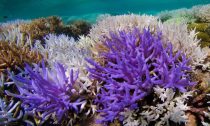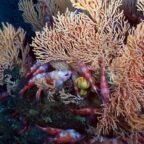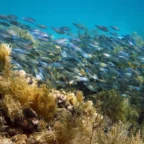
Tropical corals are famous for their captivating colors thanks to microscopic algae inhabitants. Glowing, on the other hand, is not standard fare for tropical reefs. A 2017 documentary Chasing Coral stumbled upon glowing coral reefs by accident.
The documentary follows a team of researchers and underwater photographers intent on getting footage of coral bleaching – when corals turn bright white due to stress. An underwater heatwave was expected at New Caledonia and Australia’s Lizard Island, with coral bleaching likely to follow.
The Chasing Coral team installed high-tech cameras on the ocean floor in the hopes of capturing the event. When the cameras failed, the team opted to manually photograph the reefs daily.
Instead of capturing the corals bleaching, however, the team found the New Caledonia corals glowing.
A Scientific Mystery
This ‘glowing coral’ phenomenon has been documented by scientists since the 1990s when fluorescent corals were spotted off of French Polynesia’s Society Islands. During both the coral glowing events of the 1990s and the glowing documented by Chasing Coral the unusual phenomenon was linked to an underwater heatwave.
Corals are sensitive to small changes in temperature. Just a 1°C increase in water temperature can cause corals to kick-out their microscopic algal inhabitants, zooxanthellae. Without zooxanthellae, corals are rendered colorless, or ‘bleached’. If a coral bleaches more than once in just a couple of years, there’s a good chance it will die soon after.
The vibrant, fluorescent glow, like that shown in Chasing Coral, is only known to occur after a coral bleaching event. Yet the reason only certain corals ‘glow’, and why these corals only glow after certain bleaching events, is still under investigation by scientists.
A Natural Sunscreen
Research led by Dr. Elena Bollati at the United Kingdom’s Coral Reef Laboratoryin Southampton suggests a reason for the coral glow: sunscreen. Her team’s research, which was recently published in the journal Current Biology, shows that corals may glow to invite their zooxanthellae back home.
Zooxanthellae provide corals with between 50 and 80% of their daily nutrition, making the loss of zooxanthellae devastating for coral health. After bleaching, tropical corals must re-acquire their zooxanthellae to survive.
However, the zooxanthellae themselves are light-sensitive, making the bright, white skeleton of a bleached coral inhospitable. Instead, researchers suspect some corals may ‘glow’ as a form of sunscreen to help the zooxanthellae return. In other words, Dr. Bollati’s research suggests that the glowing is not triggered by the bleaching directly, but instead by the increase in light exposure experienced by bleached corals. This discovery could also explain why the corals begin to fluoresce a couple of weeks after the onset of a bleaching event; when bleaching is in full effect and light exposure is harshest.
Not all corals produce these vibrant neon colors, however, and not all bleaching events are followed by glowing corals. Based on Dr. Bollati’s research, only corals that produce certain pigments are capable of glowing. However, the reason why only a handful of coral bleaching events are followed by an episode of glowing remains a mystery.















Social Profiles